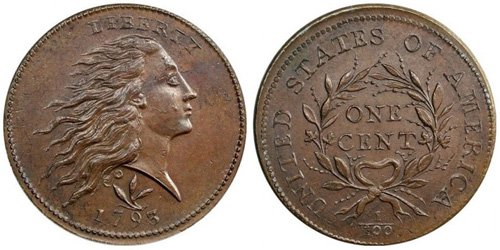Guide to U.S. Flowing Hair Cents
The United States Mint began producing coins for circulation with the half cent and cent denominations. The first series would be the Flowing Hair Large Cents, produced with different reverse designs featuring an interlinked chain and a wreath. Neither of these designs lasted longer than a few months and were quickly changed after criticism was published in newspapers nationwide. The Chain Cent had only a small mintage, and the once criticized design has come to be cherished by modern collectors. The Wreath Cent had almost double the mintage, but maintains similar allure as one of the earliest coins officially struck within the United States of America.
The Coinage Act of April 2, 1792 established the United States Mint and adopted the silver dollar as the unit within a decimal-based monetary system. The Act would authorize ten different denominations ranging from the copper half cent to the ten-dollar gold eagle. Among these denominations was the cent, with a value of 1/100 of a dollar, which would play a vital role in the early American economy. In 1792, patterns were created for various denominations including the cent, but the cents struck in the following year would have a very different appearance.

On February 27, 1793, the cent would be the first denomination struck by the United States Mint on its own premises with its own equipment. The historic production took place in a small building in Philadelphia that served as the nation’s first officially established Mint. The initial design was created by the Chief Coiner Henry Voigt. His work was much criticized, would not last long, and at least one major engraving mistake is known.
The obverse design features the head of Liberty, facing right with her hair flowing backwards. The inscription “LIBERTY” is placed above and the date below, with both inscriptions appearing in a curved manner. The reverse design contains a chain of 15 links in a continuous circle, representing the fifteen states in the Union at the time. The denomination “ONE CENT” appears at center, which is also expressed as “1/100” directly beneath. The inscription “UNITED STATES OF AMERICA” is evenly spaced around.
Contemporary newspapers criticized the depiction of Liberty as appearing frightened and having unkempt hair. The reverse design was perceived by some as representing the tyranny of British rule or slavery. Some even considered the design to be “a bad omen for Liberty.” After these criticisms, Henry Voigt quickly started working on a new design.

The second design features an improved rendition of Liberty, with more finely executed hair and facial features. A small group of leaves appears between the truncation of the neck and the date. The reverse carries a wreath composed of leaves from the cotton plant and laurel bush with sprays of berries. The denomination “ONE CENT” appears within the wreath, with the fractional version “1/100” below. The inscription “UNITED STATES OF AMERICA” surrounds the wreath, arranged with the words beginning at the lower left. Small beaded borders are placed around both the obverse and reverse.
Despite the improved appearance, the Wreath Cents still failed to gain broad approval as an appropriate representation of Liberty. Production would be abandoned once again in favor of a third design, known as the Liberty Cap Large Cent. This design was viewed more favorably and would be minted for a number of years, outlasting both the chain and wreath designs.

